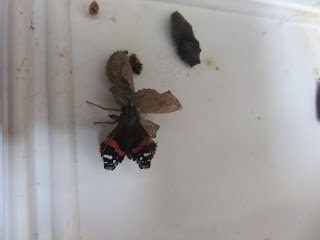Butterflies flying in March in Portugal
There are many butterfly species currently flying in the area of Portugal I live in. They are enjoying the warm spring sunshine. I saw several Green Hairstreaks (Callophrys rubi), two Clouded Yellows (Colias crocea) , two Red Admirals (Vanessa atalanta),
lots of Speckled Woods (Pararge aegeria aegeria) and several Large Whites (Pieris brassicae) on a short walk today. As well as these butterflies, I spotted two Spanish Festoons (Zerynthia rumina). I live in Quinta do Conde and like to walk through some forest and scrub on my way to the local supermarket and back. I usually see butterflies unless it is very cold, wet or windy. There are plenty of plants the Green Hairstreak butterflies can lay their eggs on here. They have a choice of Gorse (Ulex) or the Rockrose (Cistus) species. I was watching a Clouded Yellow female carefully searching in a short grassy area for Clovers and Medicks that are sprouting after some recent rains. Like all butterflies, the success of a species is very much linked to the distribution of plants they need for their caterpillars, and how well these plants are growing at the right season. Even if the correct plants are available in a given area, heat and drought can shrivel them up or prevent them growing at all. This is a disaster for a female butterfly. Every year we get several months in the summer period when the vegetation mainly goes brown or dies back to the ground. It can even be difficult finding some green blades of grass.This is a big problem for the butterflies, like the Speckled Wood and Meadow Brown (Maniola jurtina), that have larvae that feed on grasses. The latter butterfly flies later in the year and does surprisingly well here, though I have seen them sheltering in the shade of trees when it is very hot. I always wonder how they find enough grass to lay their eggs on. For the Speckled Wood in February and March this is not a problem because the grass species grow back after the winter rains. This year there has been a terrible winter drought so the land is very dry. Nevertheless many plants, including grass species, have survived, though they are nowhere near the usual size. I have been especially glad to see the small colony of the Spanish Festoon is still thriving. Last year, I didn’t see any of this species and feared that the brutal cold of the winter of 2020-2021 had wiped them out. I was obviously wrong because I have seen several of this species in the area they are found in here. Speaking of the Spanish Festoon, and its potential problems, it took me years to find the food-plant they are using in my locality. The Spanish Festoon needs any of the species of Birthwort (Aristolochia). The species that grows here is the Round-leaved Birthwort (A. rotunda). It is a delicate plant that winds its way amongst bushes and undergrowth so is not that easy to spot, especially in shaded areas. It only grows in one part here, where it is found in a lightly wooded area with a pathway and a bank. I can see for myself how this species is bound to stay where its food-plant grows because every year this location is the only place I can find this spectacular butterfly. I say spectacular because its wings are marked with darker zigzags and red dots on a yellow background. I am a migraine sufferer and the jagged lines remind me of the aura formation many people who get migraines are used to seeing. Horrible as migraines are, the Spanish Festoon is a truly beautiful species of butterfly.
All photos by Steve Andrews











